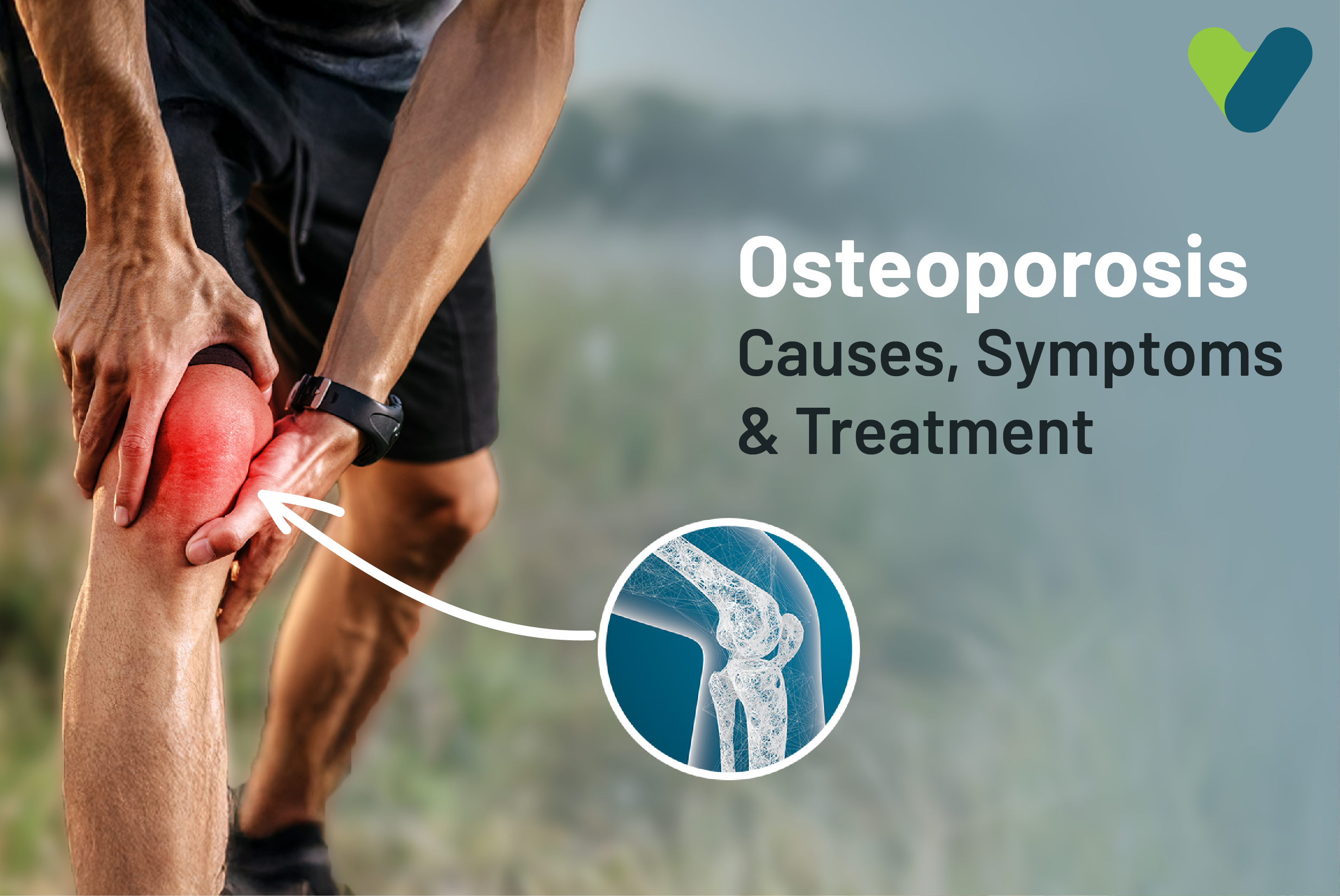Lalita, age 58, had always considered herself active and healthy. She was a big fan of yoga as well as gardening, but once, while arranging pots, she suffered a minor fall and ended up with a broken wrist. It was a baffling incident: how could such a minor incident lead to such major consequences?
Research and talking with her doctor led Lalita to learn that, in fact, she was suffering from osteoporosis. Her bone health was deteriorating, and she was completely unaware of it, like many others, without showing any signs. It also acted as a wake-up call for her to seek ways to combat the disease with all the relevant interventions available.
Wondering what exactly is osteoporosis?
Read on.
What Is Osteoporosis?
Osteoporosis is a condition in which the bones become thinner, weaker, and more likely to break.Despite the slow progression of its symptoms, this condition is one of the major contributors to mobility impairment in the elderly. It can significantly alter life and deteriorate, emotional, and physical aspects of the individual’s health.
Everything you would wish to understand about osteoporosis, including its causes, symptoms, diagnosis, treatment, and more, will be discussed in this guide that also provides useful tips on how to prevent it at any point in time.
Bone illnesses such as osteoporosis are characterized by decreased areal bone density and structural deterioration of bone tissue. The word 'osteoporosis' comes from the two words 'osteo' meaning bone and 'porosis’ referring to porous in a manner that perfectly explains the gradual loss of the insides of the bones. Bones afflicted with osteoporosis possess an internal structure that resembles a honeycomb but with bigger openings and much thinner strands.
The weakest of these bones break even with minimal stress inflicted. Any bone can be broken; however, the wrists, spine, and hips are the most often affected. Despite the greater prevalence of osteoporosis among postmenopausal women from various age groups, the disease does not spare any individual.
Why Does Bone Health Matters ?
Major functions of bones include:
- Giving your body shape
- Helping you move
- Protecting your organs
- Creating new blood cells
- Storing minerals
A Glimpse at the Numbers
Most of the individuals do not realize the prevalence of osteoporosis:
- This disease is estimated to affect over **200 million people** around the globe.
- In East, West, North, and South India, the prevalence of osteopenia was 51.3, 47.9, 55.6, and 47.4%, whereas the occurrence of osteoporosis was common in 18.4, 16.3, 16.4, and 20.7% of the sample population, respectively.
- Women are more at risk of developing osteoporosis than men because the hormone changes that happen at the menopause directly affect bone density.
- Such statistics are horrifying, which therefore calls into the need for the undertaking and rescaling to many of the concerned issues as quickly as they can.
Osteoporosis Causes
There is no single factor responsible for osteoporosis. It results from a combination of factors that occur over a period of time and contribute to reduced bone strength and density.- Age-Related Bone Loss:- Being organic structures, bones also go through the process of remodeling, which is the process that ensures continual restoration of these tissues. During this process, old bones are destroyed and new ones incorporated.
- Changes in Hormones:- Hormones play important roles in the maintenance of bone mass.
- For Women:
Estrogen is a female hormone that helps keep bones healthy. During menopause, estrogen levels drop, which can cause a rapid decline in bone density.
- For Men:
- Lack of Proper Nutrition:- Certain minerals are significant for the health of bones:
- Calcium: Important for healthy bone formation, a calcium deficit leads to the risk of osteoporosis.
- Vitamin D: Responsible for the utilization of calcium. Calcium intake is rendered useless in the absence of vitamin D.
- Protein: A healthy amount of protein enhances the structure and healing of bones.
- Lifestyle Choices:-
- Lack of exercise: Yes, a lack of exercise can increase the risk of osteoporosis. Exercising regularly can reduce the rate of bone loss and specific types of exercise can improve bone health.
- Cigarette smoking: Nicotine has a negative effect on bones by affecting the process of bone remodeling.
- Alcohol Use: Alcoholism, on the other hand, may lead to calcium loss and ultimate thinning of the bones.
Osteoporosis Risk factors
While not all will suffer the effects of osteoporosis, some factors will make some individuals more vulnerable than others.- Body Frame and Genetics.
- Family History: There is a tendency that enhances the risk of suffering from osteoporosis.
- Size of Body Frame: Those with a smaller body frame may have limited bone mass to rely on as they age.
- Age and Gender.
- Gender: Women tend to be more at risk as their bones are smaller in size and, more importantly, due to the sharp reduction of estrogen during their menopause.
- Age: This is because natural bone density decreases with advancing years.
- Underlying Health Conditions.
- Among the chronic conditions that may interfere with the general health of the bones are rheumatism, celiac, and kidney diseases.
- The prolonged administration of corticosteroids, a class of drugs that is commonly used for the treatment of inflammatory disorders, is another risk factor.
Osteoporosis Symptoms
One challenge that one has to face while living with osteoporosis lies in the fact that the disease develops with no obvious symptoms. The majority of people do not show any signs of the illness until they experience a fracture. Still, there are a few early signs to be aware of:- Early Signs.
- Loss of height with aging.
- Stooped or hunched posture
- Recurrent backaches
- Late - Stage Symptoms.
- The third type of progressive symptoms is fragility fractures.
Osteoporosis Diagnosis
It is easy to manage osteoporosis if it is diagnosed very early. Bone losses are evaluated in a series of tests, including imaging, physical examination, and getting a medical history.- BMD using DEXA scan.
- Osteopenia: T score between - 1.0 and - 2.5 (indicating early bone loss).
- Osteoporosis: A T score less than - 2.5.
- Normal Bone Density: T score of - 1.0 and above.
- Other diagnostic procedures.
- X-rays:Useful for the bones, but in particular, detecting fractures, however, cannot be used for osteoporosis that is in the early stage.
- Blood tests: These are done to eliminate other causes for loss of bone, which include thyroid abnormality or insufficient vitamin D.
Osteoporosis Treatment
The management of osteoporosis has three major aims: tackling the causes of bone loss, increasing the strength of bones, and preventing fractures.-
Osteoporosis Medication
- Bisphosphonates: referred to as 'Bisphosphonates', are the most commonly prescribed drugs to reduce the risk of fracture and attenuate bone loss. Examples include Ibandronate and Alendronate.
- Hormone Therapy: The administration of estrogens is beneficial for women after menopause in regard to bone density preservation.
- Another choice: In extreme situations, drugs, for instance, teriparatide and denosumab, are very effective.
-
Osteoporosis Lifestyle Modifications
- Dietary changes: Include more high-calcium foods such as milk, green vegetables, and cereals with added calcium.
- Workout: To enhance the growth of bones, weight-bearing exercise such as walking and resistance training should be incorporated.
- Quit Smoking and Limit Alcohol: Both these activities, reducing the amount of alcohol consumed as well as the termination of smoking, are detrimental to the bones’ health directly.
-
Osteoporosis Supplements
- Calcium:
- Vitamin D:
Vitamin D and Calcium supplements can help medications work better
How to Prevent Osteoporosis?
The best method to overcome osteoporosis is to prevent it. You can significantly cut down your risk by keeping an eye on your bones all thro- For Your Twenties and Thirties.
- Add to bone mass with calcium-rich food and regular exercise.
- Avoid tobacco use and excessive alcohol consumption.
- Continue performing resistant, weight-bearing exercises to prevent further bone loss.
- Ensure there is a proper distribution of calcium and protein in your meals.
- Ensure the environment is safe and well-lit to minimize the risk of falls.
- Use assistive devices if need be, and seek medical attention regularly.
Impacts of Osteoporosis
Osteoporosis diminishes quality of life not only by making bones more fragile.1.Physical Repercussions.
Prolonged recovery times, loss of motion, and persistent discomfort are some outcomes of fracturing. Especially in the elderly population, hip fractures are associated with a high rate of mortality.
2.Emotional Repercussions.
The fear of falling down or breaking bones may result in anxiety, depression, and withdrawal from society.
Osteoporosis - Conclusion
Osteoporosis may be regarded as a “silent disease,” but It, however, needs not be left unattended. It’s possible to have healthy bones and a physically active life with proper diagnosis, treatment, and associated interventions at early stages. Do something to protect your bones as well as encourage others. Consult an Orthopedic Surgeon today!Also Read : All about Osteomalacia
References
- OrthoInfo - AAOS - Osteoporosis. American Academy of Orthopaedic Surgeons [Internet].
- What is Osteoporosis and What Causes It?. Bone Health & Osteoporosis Foundation (BHOF) [Internet].
- Osteoporosis: Diagnosis, Treatment, and Steps to Take. National Institute of Arthritis and Musculoskeletal and Skin Diseases (NIAMS) [Internet].


